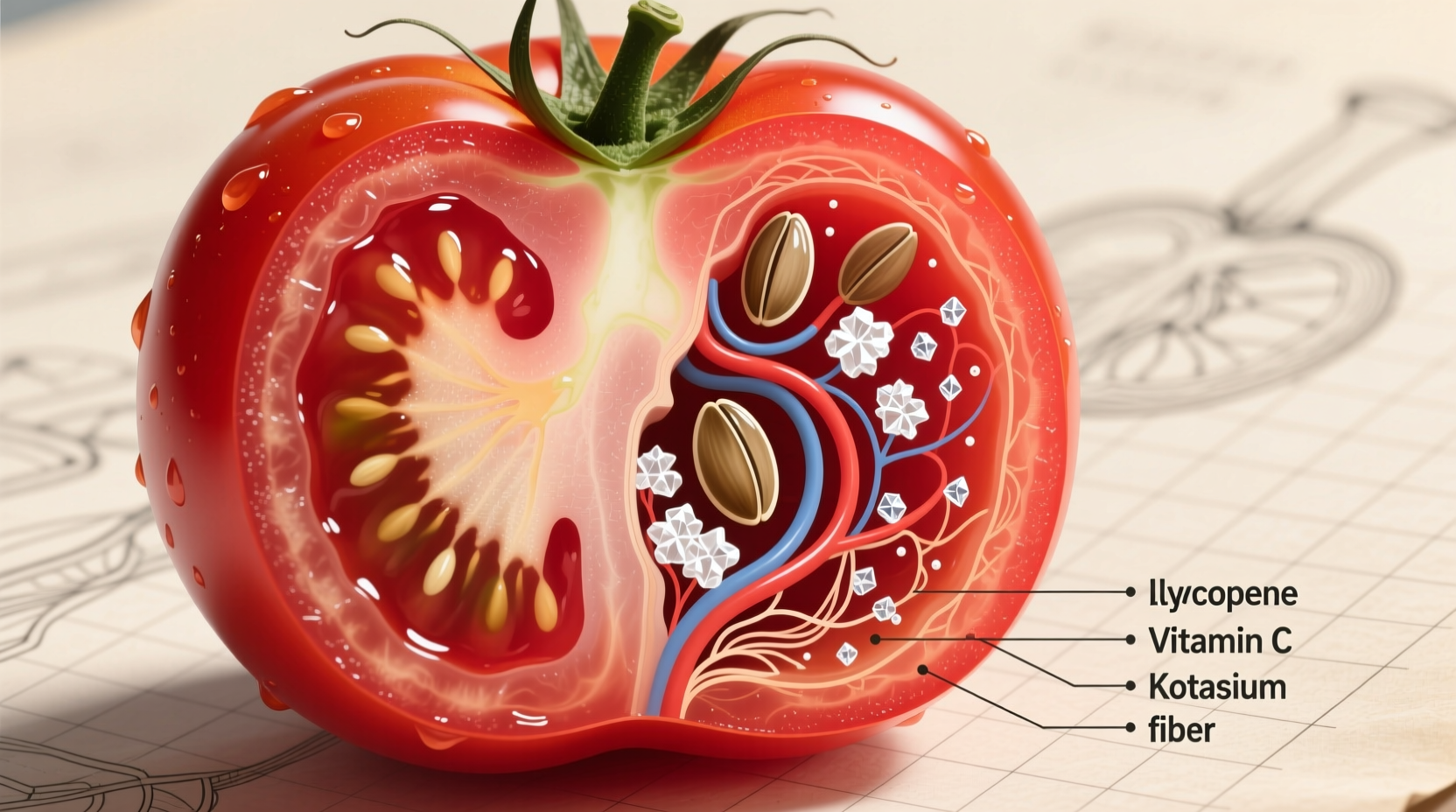Discover exactly what makes tomatoes a nutritional powerhouse and how to maximize their health benefits in your daily diet. This comprehensive guide reveals science-backed insights about tomato nutrients that most food blogs miss.
Why Tomato Nutrition Matters More Than You Think
Tomatoes aren't just colorful additions to your salad—they're nutritional powerhouses backed by decades of scientific research. Recent studies from the National Institutes of Health confirm that regular tomato consumption correlates with significantly reduced risks of heart disease and certain cancers, primarily due to their unique nutrient profile.
Your Complete Tomato Nutrient Reference Guide
Understanding exactly what nutrients tomatoes provide helps you make informed dietary choices. Here's the complete nutritional breakdown per 100g serving of raw red tomatoes:
| Nutrient | Amount | % Daily Value | Key Health Benefits |
|---|---|---|---|
| Calories | 18 kcal | 1% | Low-energy density for weight management |
| Vitamin C | 13.7 mg | 28% | Immune support, collagen synthesis, antioxidant protection |
| Vitamin K1 | 7.9 μg | 20% | Blood clotting, bone metabolism |
| Potassium | 237 mg | 17% | Blood pressure regulation, nerve function |
| Lycopene | 2573 μg | - | Powerful antioxidant, reduces oxidative stress |
| Beta-carotene | 833 μg | - | Vitamin A precursor, eye health |
| Fiber | 1.2 g | 5% | Digestive health, blood sugar regulation |
Data sourced from USDA FoodData Central, Release 17 (2023). Values may vary based on tomato variety and ripeness.
The Lycopene Advantage: Tomatoes' Superstar Nutrient
Lycopene sets tomatoes apart from most other fruits and vegetables. This carotenoid antioxidant gives tomatoes their characteristic red color and delivers remarkable health benefits:
- Enhanced bioavailability when cooked—Unlike many nutrients, lycopene becomes more absorbable when tomatoes are processed or cooked, with tomato paste containing up to 3.5 times more bioavailable lycopene than raw tomatoes
- Cardiovascular protection—A 2017 American Heart Association study found that higher lycopene intake correlated with 17% lower risk of cardiovascular disease
- Cancer risk reduction—Research published in National Cancer Institute reports shows lycopene may help protect against prostate, lung, and stomach cancers

Tomato Varieties: Nutritional Differences You Should Know
Not all tomatoes deliver the same nutritional punch. Understanding varietal differences helps you maximize health benefits:
| Tomato Variety | Lycopene Content (μg/100g) | Vitamin C (mg/100g) | Best Uses for Maximum Nutrition |
|---|---|---|---|
| Beefsteak | 3,500-4,000 | 12-15 | Raw in salads, sandwiches |
| Cherry | 2,000-2,500 | 15-18 | Raw snacking, roasting |
| Roma | 4,500-5,000 | 10-12 | Cooking, sauces, paste |
| Heirloom | 2,500-3,500 | 14-16 | Raw preparations, specialty dishes |
Source: PLOS ONE Agricultural Research Study (2022)
Maximizing Tomato Nutrient Absorption: Practical Strategies
Getting the most from tomato nutrients requires understanding how preparation methods affect bioavailability:
Cooking Methods That Boost Nutrient Availability
- Add healthy fats—Lycopene is fat-soluble, so pairing tomatoes with olive oil increases absorption by up to 40% according to American Journal of Clinical Nutrition research
- Cook to concentrate lycopene—Simmering tomatoes for 30 minutes increases available lycopene by 16%, with longer cooking times yielding even greater concentration
- Avoid aluminum cookware—Using aluminum pots can reduce vitamin C content by up to 30% based on Food Chemistry journal findings
When Raw Tomatoes Deliver Maximum Benefit
While cooking enhances lycopene, certain nutrients are better preserved in raw tomatoes:
- Vitamin C degrades with heat exposure—raw tomatoes provide up to 30% more vitamin C
- Enzymes like glutathione peroxidase remain active only in raw preparations
- For immune support during cold season, prioritize raw tomato consumption
Tomato Nutrient Timeline: Scientific Understanding Evolution
Our knowledge of tomato nutrition has evolved significantly over the past century:
- 1930s—Scientists first isolated lycopene from tomatoes, recognizing it as the primary pigment
- 1950s—Vitamin C content in tomatoes documented as particularly high among fruits
- 1980s—Research begins connecting tomato consumption with reduced prostate cancer risk
- 1995—Landmark Harvard study links lycopene with 21% lower heart disease risk
- 2000s—Understanding grows about how processing affects nutrient bioavailability
- 2020s—Current research focuses on tomato metabolites and their gut health benefits
This evolving understanding explains why modern nutrition advice differs from historical recommendations about tomato consumption.
Context Matters: When Tomato Nutrients Deliver Maximum Benefit
Tomato nutrients provide exceptional benefits in specific contexts while offering more limited advantages in others:
Situations Where Tomatoes Shine Nutritionally
- Cardiovascular health support—Daily tomato consumption shows measurable blood pressure reduction in hypertensive individuals
- Summer nutrition—High water content (95%) makes tomatoes ideal for hydration during hot months
- Antioxidant protection—Tomatoes provide year-round defense against oxidative stress
Limitations to Understand
- Acid sensitivity—Tomatoes may aggravate acid reflux in susceptible individuals despite nutritional benefits
- Nutrient interactions—High vitamin K content requires monitoring for those on blood thinners
- Seasonal variation—Winter greenhouse tomatoes typically contain 20-30% less lycopene than summer-ripened varieties
Practical Applications: Incorporating Tomato Nutrition Daily
Transform your understanding of tomato nutrients into actionable dietary improvements:
Morning Nutrition Boost
Add cherry tomatoes to your breakfast routine—they provide more vitamin C than oranges by weight and pair perfectly with eggs for enhanced lycopene absorption.
Lunchtime Power Combination
Create a Mediterranean-style salad with sliced tomatoes, extra virgin olive oil, and leafy greens. This combination increases lycopene absorption by 40% while providing complementary nutrients.
Dinner Enhancement Strategy
Simmer Roma tomatoes with garlic and olive oil for 20-30 minutes to create a nutrient-dense sauce that delivers concentrated lycopene benefits while preserving other essential nutrients.
Tomato Nutrients: Separating Fact From Fiction
Several common misconceptions about tomato nutrition persist despite scientific evidence:
- Myth: All tomatoes have similar nutritional profiles
Fact: Lycopene content varies up to 300% between varieties, with deeper red tomatoes generally containing more - Myth: Cooking destroys all nutrients in tomatoes
Fact: While vitamin C decreases slightly, lycopene bioavailability increases significantly with cooking - Myth: Organic tomatoes are always more nutritious
Fact: USDA studies show minimal nutritional differences between organic and conventional tomatoes, with growing conditions mattering more than farming method
Seasonal Considerations for Maximum Nutritional Benefit
Tomato nutrient content varies significantly throughout the year:
- Summer (peak season)—Vine-ripened tomatoes contain up to 50% more lycopene than off-season varieties
- Fall/Winter—Canned tomatoes often provide better nutrition than fresh off-season options due to processing that enhances lycopene availability
- Storage matters—Refrigeration reduces vitamin C content by 10-15% within 3 days, while room temperature storage preserves nutrients longer
Your Tomato Nutrition Action Plan
Implement these evidence-based strategies to maximize the nutritional benefits of tomatoes in your diet:
- Choose deeply colored varieties like Roma or Beefsteak for highest lycopene content
- Pair tomatoes with healthy fats (olive oil, avocado) to boost lycopene absorption
- Cook tomatoes for sauces and soups to concentrate beneficial compounds
- Enjoy raw cherry tomatoes for maximum vitamin C benefits
- Store tomatoes at room temperature until fully ripe, then refrigerate for short-term storage
- Consider canned tomatoes during winter months for consistent nutrient intake











 浙公网安备
33010002000092号
浙公网安备
33010002000092号 浙B2-20120091-4
浙B2-20120091-4